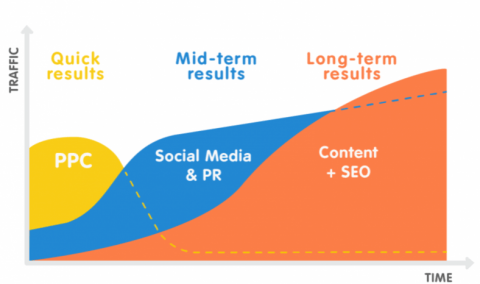TL;DR ‘it depends’
SEO is fairly unique amongst all of the digital marketing channels because it’s free* and has the potential to drive large amounts of traffic.
SEO can drive consistent, reliable levels of traffic; it is, of course, subject to changes in market demand, competitor activity, SERP changes and unlike paid search (see graph below); algorithmic updates but SEO performance is generally quite predictable and doesn’t necessarily need daily or hourly fettling and attention in order to maintain status quo (outside of dealing with major technical issues).

Image courtesy of: https://session-media.com/
The flip side of this is that, in order to elevate a site above its baseline organic performance level, time as well as resource are required. The process might look something like this;
- Time and resource are required to perform an initial audit to uncover issues and opportunities.
Some of these issues and opportunities may be ‘quick wins’, i.e. things that can be capitalized upon by making a small tweak; but for a site that hasn’t had any SEO work carried out previously, quick wins will usually be few and far between – most optimization tasks will be quite substantial, e.g. creating new pages to ensure as much market demand as possible is being captured or optimizing every indexable page on the site to make sure they’re all uniquely valuable in their own right.
- The work then of course needs to be performed, the speed at which this work can be completed will depend on the amount of hours available and the size of the site
- Once the work is completed, the changes will need to be implemented by the client. In some situations, the SEO may have access to the client’s site which means implementation can happen more quickly.
The speed at which SEO performance gains can be realized depends on how quickly each step of this process can be performed (although thoroughness should never be compromised in favour of speed), and crucially, the lead time between each step.
Let’s say an overall SEO audit takes one day. This might identify several more detailed pieces of work that need to be carried out; if optimization of pages titles takes a further day, and all these changes can be implemented can be implemented the following day, then everything that’s within the gift of the SEO practitioner and the client might be complete in 3 days.
Once the changes are implemented however, it’s up to search engines to crawl the pages that have been edited, and recognize the changes that have taken place. If the site is well established and already gets crawled regularly, these changes may be crawled and recognized within the space of a day (you can check when a particular page was last crawled using a log file analysis tool such as Screaming Frog Log File Analyser and check when they were last cached by checking the cached version of the page in the search results).
Search engines are constantly algorithmically assessing which pages are most relevant for a given query, so if the changes you’ve made to your pages are enough to make them more relevant for a given query, you may see positive ranking movements within the space of a week (of course this depends on many factors – there may be no movement at all if competing pages have also improved).
In this ‘ideal’ scenario we’re estimating ten days from the initial audit to a tangible performance uplift.
In reality however, this process will generally take a lot longer, particularly if the site is brand new.
Let’s take a look at some of the factors which could affect the time this process takes; both in terms of the areas we can control, and the ones we don’t have direct control over (or at least can’t change quickly).
What We Have More Control Over
Resource (Labour, Time and Budget)
Resource is one of the limiting factors which affects how quickly results can be seen. More resource in terms of labour (and/or time) means that SEO opportunities can be identified, acted upon and implemented more quickly.
On the client side, more resource will also minimize the time taken between these steps (i.e. approving the strategy, signing off proposed changes, and implementing the agreed changes).
Brand Strength
Having a well-know brand can have many positives (see below: What We Have Less Control Over), but it can also have disadvantages. Businesses with a strong brand can sometimes be less agile because a brand filter will need to be applied across any on-page changes that are proposed. This can slow down the speed at which approval and implementation can happen.
Regulation
Some industries such as personal finance, insurance and healthcare can be heavily regulated. This means that an additional level of scrutiny will need to be applied to any on-page changes to ensure that content remains compliant with industry regulations.
What we Have Less Control Over;
Crawl Frequency
Generally, older more well-established domains will have more external links, will have built up more trust and will be crawled more regularly, all of this means that on-page changes will be recognized more quickly by search engines.
Number of Referring Domains/Backlinks
Generally speaking, sites with more links will have a greater ability to realise benefits from improved relevancy (e.g. keyword targeting) than sites with less links. This is often a benefit that large brands enjoy. Initially the SEO team or practitioner will have less control over this, but if link acquisition is part of the SEO strategy then this should become less of an issue over time.
Changes in The Market
Market changes can mean that even if on-site changes improve SEO performance, less traffic may be acquired after the optimisations have taken place due to fewer people searching for your brand or your products. This is why it’s important to use metrics like visibility and not just impressions or clicks to judge SEO performance.
Competitor Activity
As mentioned above if the competitors for the area of the market you’re looking to increase your share of are also making improvements, you could end up maintaining your market share rather than increasing it.
Paid Media
Let’s say you improve your position for a particular keyword, but at the same time, a competitor (or your own paid media team) start bidding on that keyword. This will likely mean that the organic result will have the amount of clicks it receives stymied by the paid result. Your organic and paid media teams should be working together to ensure that both channels are working harmoniously and that budgets are being maximized.
SERP Changes
Google are constantly making changes to Search Results pages and in 2022, there are more SERP features than ever before. The number and type of features depend on the query, but some results pages can be cluttered with knowledge graphs, featured snippets, Google Shopping feeds, images and numerous other features. The more features that appear, the more distracted users may be from clicking on the regular web links. Rather than seeing this as a disadvantage however, we should be looking to snag these SERP features where possible on order to capture as much SERP real estate as possible (so long as this doesn’t detract from your main KPIs).
Can you Calculate Exactly How Much Traffic You’ll Get?
Like any other channel, forecasting SEO traffic will be a best guess, but there’s certainly some science you can apply to the process to make it more reliable.
Individual keyword volumes can be used to calculate the entire addressable market. Estimated or target positions for each keyword should then be estimated, along with estimated click-through-rates.
Traffic-per-keyword can then be estimated, the new traffic total can then be used to calculate conversions and revenue (if relevant) based on current conversion rate and average order value.
For more on this topic, check out our recent post on forecasting SEO performance.
Should Any of This Change Amid the Covid-19 Crisis?
Covid-19 is having far-reaching and never-before-seen effects on the world as a whole, certain industries are impacted more than others, but as a business owner looking to improve organic search performance, should this alter your strategy?
Of course, this depends on your overall business goals and your budget, but the longer lead times required to realise SEO performance as well as the lower cost* could make SEO a smart channel to invest in the current climate.
Why?
Although demand in your industry may be seeing a downturn, Search Engine Algorithms don’t stop working, so putting the leg work in now to ensure you’re site is as technically sound as possible, your content is world-class, your keyword targeting is on-point, and you’re doing everything you can acquire high-quality external links could see you emerge out the other side of the Covid lockdown in a much stronger position than your competitors; ready to capture as much demand as possible once the markets begin to recover (or to take advantage of the increased demand out there if you operate in a an industry that is benefitting from the crisis).
As for the here and now, traffic volumes should be contextualized against market demand (which has the potentially to wildly fluctuate as the situation develops), tools like Google Trends and Keyword Planner can help you get an idea of the market changes allowing you to judge your performance against the current socio-economic backdrop.
Conclusion
While in some situations, SEO work can have a rapid, substantial impact, generally it takes a significant amount of time from starting the work to starting to see incremental performance gains.
It is very difficult to definitively say how long this process will take for any one site since there are so many moving parts, but as a guide, 3 months is a sensible length of time to use as an initial benchmark.
For most sites, SEO works much better as long term investment rather than a campaign style ‘project’ with a definitive start and end date. Performance improvements can of course be achieved in this way, but SEO performance gains can compound over time, meaning that the longer you ‘invest’ in the channel for, the more performance will ‘compound’ and improve exponentially over time.
The consultancy aspect of an SEO offering is also good to have on board on a long term basis in order to help deal with unexpected technical issues or algorithm changes that could negatively impact performance.
*The cost of SEO depends on your definition of ROI, CPA, ROAS or whatever other metric you want to use to assess the cost vs benefit of your marketing efforts, but if we’re talking about ad-spend, SEO is effectively a ‘free’ channel.

Leave a Reply